To elevate your mobile photography skills, master key framing techniques. Implement the rule of thirds by placing subjects along gridlines for balanced compositions. Use leading lines to guide the viewer's eye and create depth. Embrace symmetry and patterns to captivate attention, and incorporate natural frames like doorways or branches for context. Experiment with negative space to enhance focus, and add foreground interest for dimension. Don't forget to play with perspective and angles for unique shots. By combining these framing secrets, you'll transform ordinary scenes into extraordinary photographs. Release the full potential of your smartphone camera and watch your images come to life.
Rule of Thirds
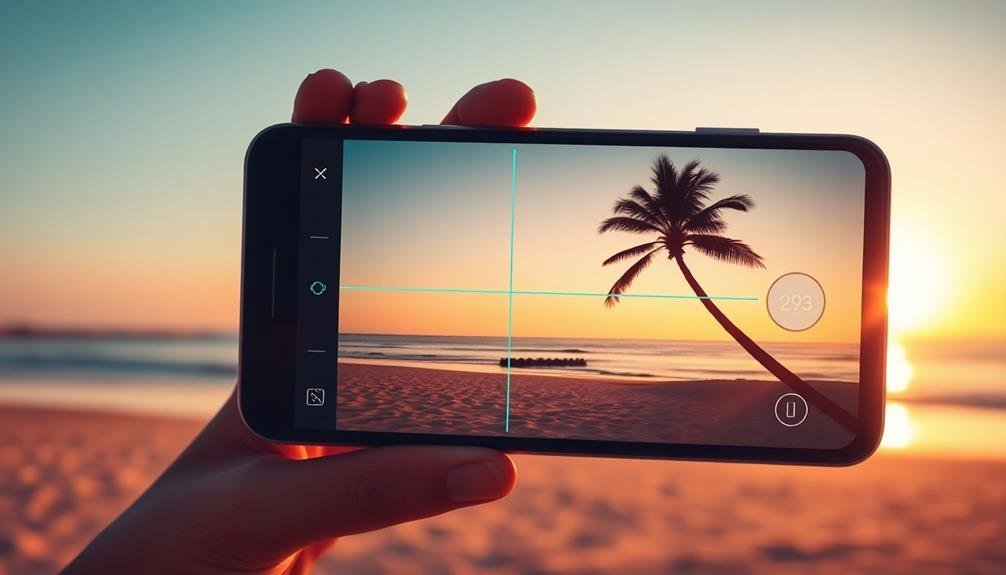
Composition is key in mobile photography, and the Rule of Thirds is a fundamental principle you'll want to master. This rule divides your frame into a 3×3 grid, creating nine equal sections. The idea is to place your main subject along these lines or at their intersections, rather than centering it.
Most smartphones have a grid option in their camera settings. Turn it on to help you visualize the Rule of Thirds while shooting. When framing your shot, position important elements along these gridlines or at their intersections. This creates a more balanced and visually appealing composition.
For landscapes, try aligning the horizon with the top or bottom horizontal line. In portraits, position your subject's eyes along the upper third.
When capturing architecture, place vertical elements along the left or right vertical lines.
Leading Lines
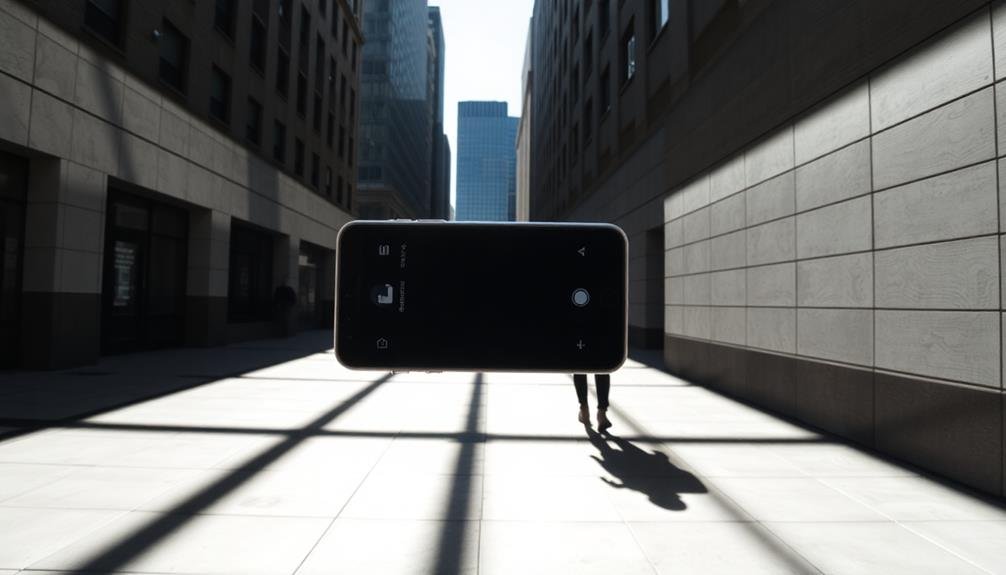
Another powerful compositional tool in mobile photography is leading lines. These are visual elements that guide the viewer's eye through the image, creating depth and drawing attention to your main subject. You'll find leading lines everywhere: roads, fences, buildings, shorelines, or even patterns in nature.
To use leading lines effectively, start by identifying strong linear elements in your scene. Position your camera so these lines lead towards your focal point. Experiment with different angles to create more dynamic compositions.
Try shooting from low angles to emphasize converging lines, or use diagonal lines for a sense of movement. Remember, leading lines don't always have to be straight. Curved or winding paths can add a sense of mystery and intrigue to your photos.
In urban settings, look for staircases, subway tunnels, or architectural features that create strong directional cues. When capturing leading lines with your mobile device, use the grid feature to align your lines precisely.
Don't be afraid to move around and explore various perspectives. With practice, you'll develop an eye for spotting and utilizing leading lines to create more compelling and visually engaging mobile photographs.
Symmetry and Patterns
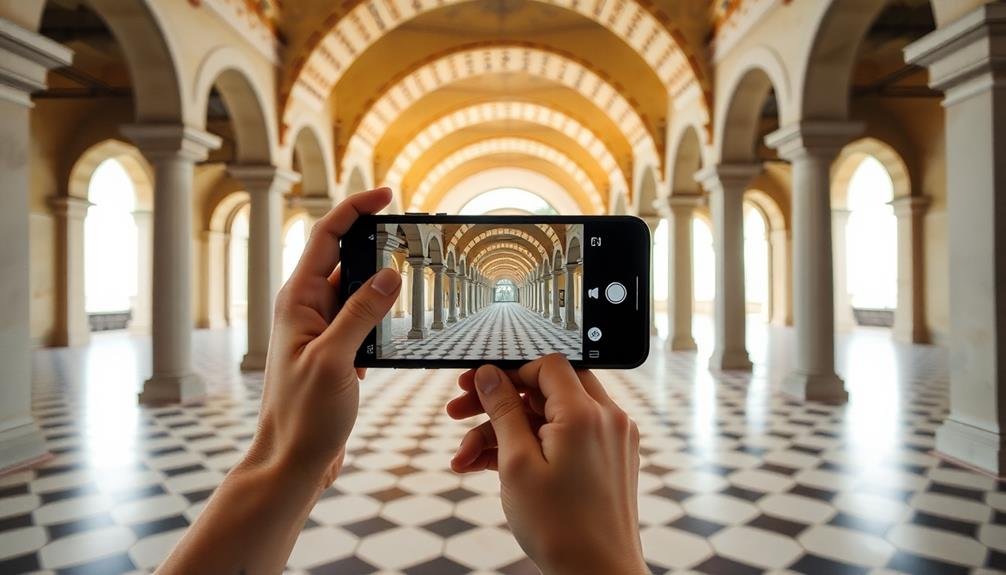
While leading lines guide the eye, symmetry and patterns captivate it. These visual elements create a sense of order and harmony in your mobile photographs, instantly drawing viewers in.
To harness their power, start by training your eye to spot symmetrical compositions in your surroundings. Look for reflections in water, mirrored architecture, or perfectly balanced natural scenes.
When you've found a symmetrical subject, position your phone's camera to capture the central axis. Use gridlines to guarantee perfect alignment. For vertical symmetry, try placing the horizon line in the middle of your frame. With horizontal symmetry, center your subject along the vertical axis.
Patterns, on the other hand, offer repetition and rhythm. They're everywhere—in nature, architecture, and even everyday objects.
To photograph patterns effectively, fill your frame with the repeating elements. Experiment with different angles to create unique perspectives. Sometimes, breaking the pattern with a contrasting element can add intrigue to your shot.
Don't forget to play with light and shadow. They can enhance symmetry and patterns, adding depth and dimension to your mobile photographs.
With practice, you'll master these composition techniques and elevate your mobile photography skills.
Natural Frames
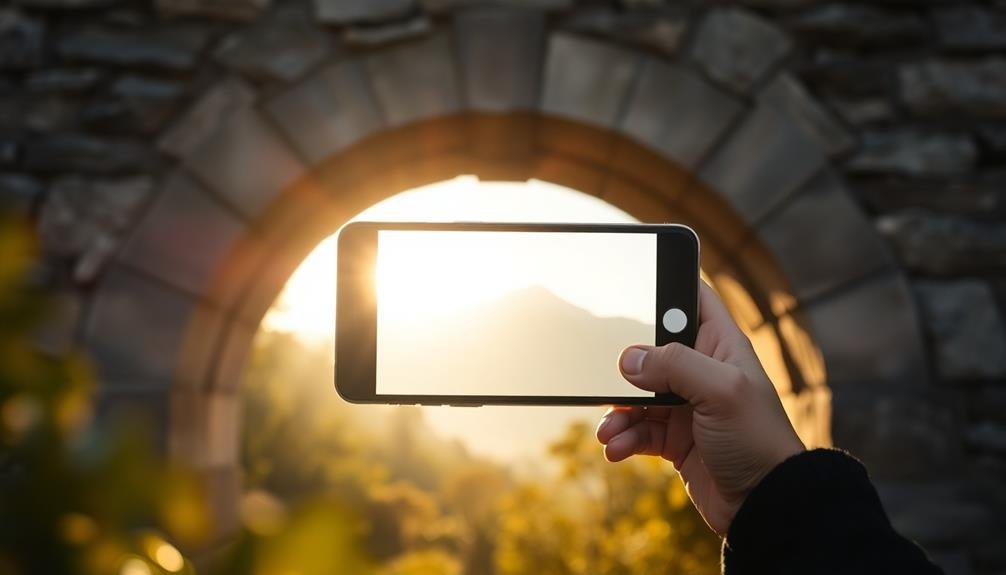
Doorways, arches, and tree branches serve as nature's picture frames, waiting to be discovered by keen-eyed mobile photographers. These natural frames can add depth, context, and visual interest to your shots. When you're out exploring, keep an eye out for elements that can frame your main subject.
To use natural frames effectively, position your subject within the frame created by the surrounding elements. This could be a person standing in a doorway, a landmark seen through an arch, or a wildlife subject peeking through foliage. Experiment with different angles and distances to find the most compelling composition.
Pay attention to the shape and size of the frame in relation to your subject. A tight frame can create intimacy, while a larger frame can emphasize the surrounding environment. Consider the lighting as well; natural frames can create interesting shadows or highlight your subject through contrast.
Don't limit yourself to obvious frames. Look for creative opportunities like reflections in water, gaps between rocks, or even manmade structures like fences or windows.
Negative Space
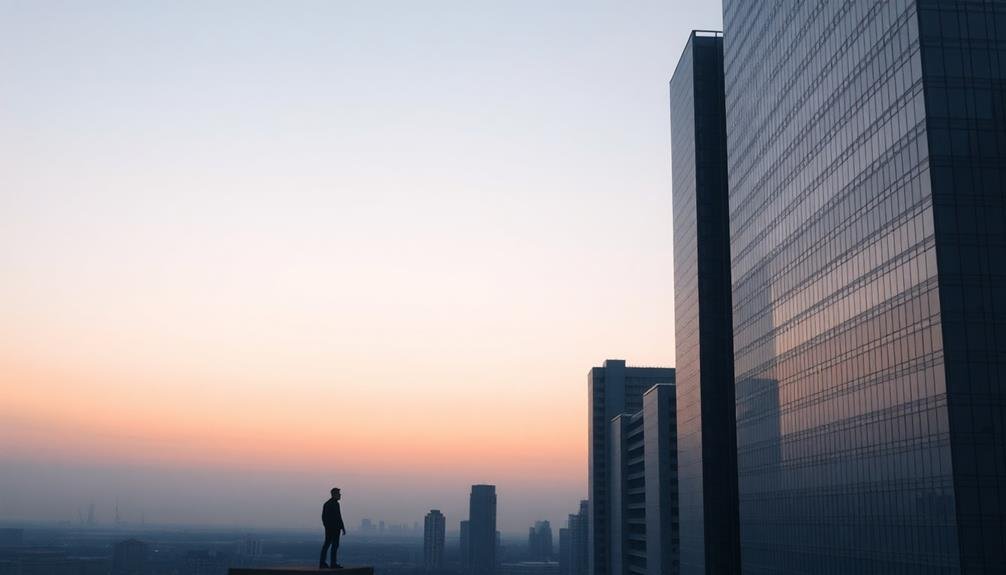
Embrace the power of emptiness in your mobile photography by incorporating negative space.
You'll find that strategically using blank areas can create balance and draw attention to your main subject.
Power of Emptiness
The power of emptiness in mobile photography is often underestimated. By embracing negative space, you're not just capturing an image; you're telling a story. Empty areas in your frame can direct attention, create balance, and evoke emotions.
When you're composing your shot, look for opportunities to incorporate vast expanses of sky, water, or plain surfaces.
To effectively use the power of emptiness:
- Isolate your subject against a minimalist background
- Use symmetry to create a sense of calm and order
- Experiment with different ratios of subject to negative space
Remember, emptiness isn't about lack of content; it's about purposeful composition. It can make your main subject stand out dramatically or convey a sense of solitude and contemplation.
As you practice, you'll develop an eye for spotting these opportunities in everyday scenes.
Don't be afraid to push the boundaries. Sometimes, the most impactful mobile photos are those where the subject occupies only a small portion of the frame. This technique can create intrigue and draw viewers into the image, encouraging them to explore the story you're telling through your lens.
Balance and Focus
Building on the concept of emptiness, balance and focus through negative space are essential elements in mobile photography composition. When you use negative space effectively, you'll create images that are visually striking and emotionally impactful.
To achieve this, start by identifying your main subject and consider how much empty space surrounds it. Experiment with different ratios of subject to negative space. A 1:2 ratio often works well, but don't be afraid to push boundaries.
As you frame your shot, pay attention to how the empty areas guide the viewer's eye to the focal point. Use leading lines, patterns, or contrasting colors within the negative space to enhance this effect.
Remember that balance doesn't always mean symmetry. Asymmetrical compositions can be equally powerful when executed thoughtfully. Try placing your subject off-center and use the surrounding emptiness to create tension or intrigue.
When editing, resist the urge to crop out negative space. Instead, embrace it as a crucial component of your image. By mastering the art of balance and focus through negative space, you'll elevate your mobile photography to new heights.
Foreground Interest
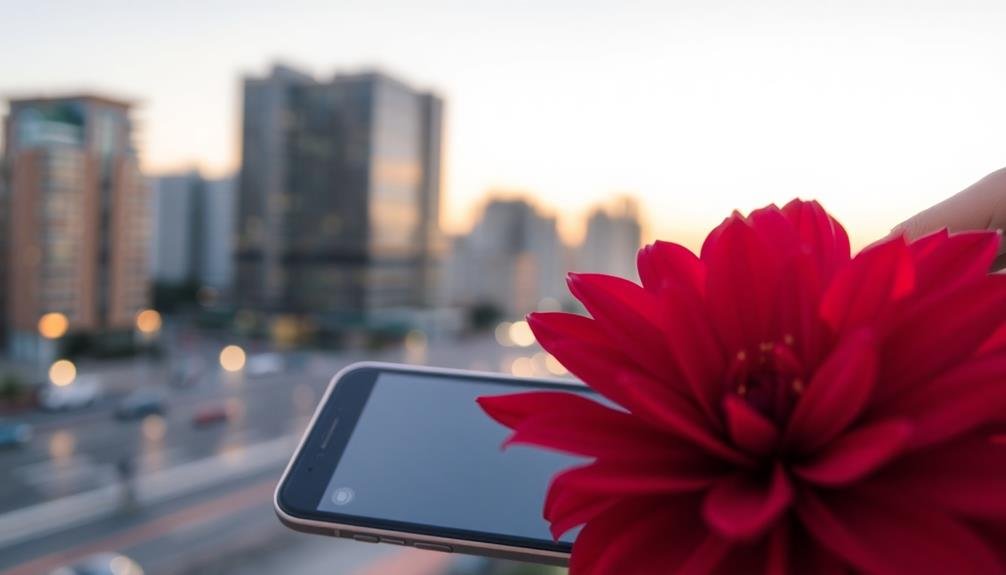
Incorporating foreground elements in your mobile photography can transform ordinary scenes into enchanting compositions.
By adding objects in the front of your frame, you'll create depth and context, guiding the viewer's eye through the image.
You can also use foreground elements to create a natural frame within your photo, enhancing visual interest and drawing attention to your main subject.
Add Depth and Context
By incorporating foreground elements into your mobile photos, you'll instantly add depth and context to your images. This technique creates a sense of dimension, drawing viewers into the scene and making them feel as if they're part of the experience.
Look for interesting objects or textures in the foreground that complement your main subject, such as flowers, rocks, or architectural details.
When composing your shot, position these foreground elements strategically to frame your subject or lead the eye towards it. Experiment with different angles and perspectives to find the most compelling arrangement.
Remember to adjust your focus and exposure accordingly, ensuring both the foreground and background elements are sharp and well-exposed.
Adding depth and context through foreground interest can:
- Create a sense of scale
- Enhance the story-telling aspect of your image
- Provide visual interest and balance
Don't be afraid to get creative with your foreground elements. Use reflections in water or glass, incorporate shadows, or frame your subject with natural elements like tree branches.
Frame Within a Frame
A powerful extension of using foreground elements is the "frame within a frame" technique. This approach involves using elements within your scene to create a natural border around your main subject. By doing so, you'll add depth, context, and visual interest to your mobile photos.
To implement this technique, look for architectural features like doorways, windows, or arches. Natural elements like tree branches, rock formations, or even people can also serve as effective frames. Position yourself so that these elements surround your primary subject, drawing the viewer's eye inward.
When framing your shot, pay attention to symmetry and balance. You don't always need a complete frame; partial frames can be equally effective. Experiment with different angles and distances to find the most compelling composition.
Consider the mood you want to convey. A tight frame can create intimacy or confinement, while a looser frame might suggest openness or freedom. Use the frame to tell a story or highlight the relationship between the subject and its environment.
Create Visual Interest
Foreground interest is a powerful tool to enhance your mobile photography. By incorporating elements in the foreground of your frame, you'll create depth and draw viewers into your image. This technique adds dimensionality to your photos, making them more engaging and visually appealing.
To create foreground interest, look for objects or textures that can complement your main subject. These elements should enhance the overall composition without overpowering the primary focus. You can use foreground elements to:
- Frame your subject
- Lead the viewer's eye into the scene
- Add context or tell a story
Experiment with different angles and perspectives to find the most effective foreground elements. Get low to the ground to include interesting textures or objects in the bottom of your frame.
Try shooting through foliage, windows, or other partially obscuring elements to add intrigue.
Remember to maintain a balance between foreground and background. Adjust your focus and exposure to guarantee both areas are properly captured.
With practice, you'll develop an eye for incorporating foreground interest seamlessly into your mobile photography, resulting in more dynamic and engaging images that stand out from the crowd.
Perspective and Angles

Capturing unique perspectives and angles can transform ordinary scenes into extraordinary photographs. To achieve this, experiment with different viewpoints. Get low to the ground for a worm's-eye view, or find a high vantage point for a bird's-eye perspective. These unconventional angles can add drama and intrigue to your images.
Don't be afraid to tilt your phone. A slight angle can create dynamic compositions, especially for architectural shots or landscapes. Try the "Dutch angle" technique, where you deliberately tilt the horizon to create tension or unease in your photo.
Explore foreground elements to add depth. Position objects in the foreground to frame your main subject or lead the viewer's eye into the scene. This technique can create a sense of scale and dimension in your images.
Use leading lines to guide the viewer's gaze. Look for natural lines in your environment, such as roads, fences, or building edges, and use them to direct attention to your focal point. This technique can create powerful, visually compelling compositions that draw viewers into your photographs.
Frequently Asked Questions
How Do I Stabilize My Phone Camera for Sharper Images?
To stabilize your phone camera, you'll want to hold it with both hands, tuck your elbows in, and use a stable surface when possible. Try using a tripod or gimbal for extra stability. Don't forget to use your phone's stabilization features.
What Are the Best Mobile Apps for Advanced Photo Editing?
You'll find several great options for advanced mobile photo editing. Snapseed, Lightroom Mobile, and VSCO offer powerful tools. For more specialized edits, try Photoshop Express or Afterlight. These apps will help you transform your photos into stunning works of art.
How Can I Capture Motion Blur Intentionally in Mobile Photography?
To capture motion blur intentionally, you'll want to use a slow shutter speed. Try panning with your moving subject or keeping your phone still for stationary objects. Many camera apps offer manual controls for this technique.
What's the Ideal Resolution and Aspect Ratio for Social Media Posts?
For social media posts, you'll want to use a 1:1 square aspect ratio for Instagram, 16:9 for YouTube, and 9:16 for TikTok and Instagram Stories. Aim for at least 1080p resolution to guarantee crisp, high-quality images.
How Do I Achieve a Bokeh Effect With a Single-Lens Smartphone Camera?
You can create a bokeh effect with a single-lens smartphone by getting close to your subject, tapping to focus, and using portrait mode if available. Try shooting in low light or using a background with small light sources.
In Summary
You've now got a toolkit of framing secrets to transform your mobile photography. Don't be afraid to experiment with these techniques. Mix and match the rule of thirds, leading lines, symmetry, natural frames, negative space, foreground interest, and unique perspectives. With practice, you'll develop an eye for compelling compositions. Remember, great photos aren't just about the subject; they're about how you frame it. So grab your phone and start creating stunning images today!





Leave a Reply